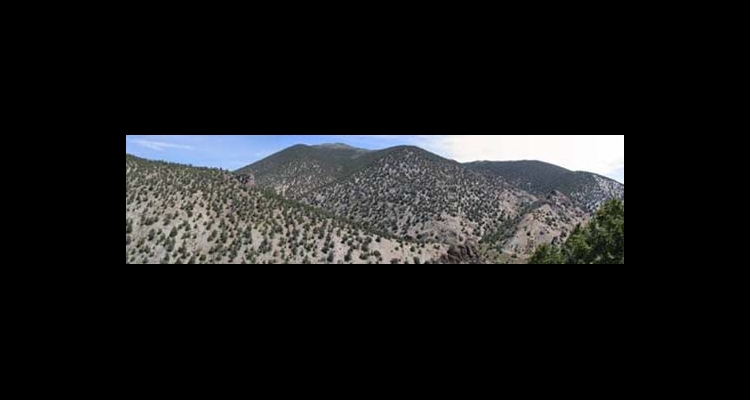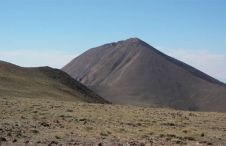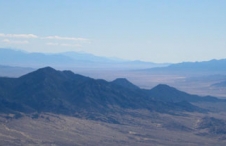Flora and Fauna of the Great Basin Mountains
The Great Basin, despite its name, is a mountainous region. It contains hundreds of mountain ranges, including thirty-three that reach a height of more than 10,000 feet. As with mountains everywhere, those in the Great Basin house many plant and animal species not found in the neighboring lowlands; for instance, high Great Basin mountains typically have woodlands of pinyon pine and Utah juniper on their lower slopes and forests of several other conifer species higher up, whereas the surrounding valleys generally have no naturally growing trees except near watercourses. Although these mountains as a whole share many species with the Sierra Nevada and, especially, with the Rocky Mountains, the set of plants and animals in Great Basin ranges is distinctive. The unique flora and fauna of Great Basin mountains can be explained to a large degree by two obvious characteristics: their aridity and their isolation.
The Great Basin is dry because it lies in the rain shadow of mountains to the west. The majority of storm systems in the area occur in winter and come from the Pacific. These storms drop most of their moisture as rain in the Coast Ranges or snow in the Sierra Nevada, leaving little for the Great Basin to the east. The difference in precipitation is perhaps most obvious in the high-elevation coniferous forest: the tall, snow-fed Sierra forests are replaced in the Great Basin ranges by shorter, dry-adapted forests or woodlands or even by a treeless sagebrush zone. Aridity probably also affects the total numbers of species: Less moisture likely translates to fewer potential opportunities for plants and animals in Great Basin mountains.
Great Basin ranges in general share many more plant (and perhaps animal) species with the Rocky Mountains than with the Sierra Nevada. For example, all eleven conifer species found above the pinyon-juniper zone in the central Great Basin also occur in the Rockies, but only three of them are found in the Sierra. Aridity, along with soil type, might explain this bias toward Rocky Mountain species. The Great Basin is essentially downwind from the Sierra Nevada, which should make it easier for Sierran, rather than Rocky Mountain, plants to reach the Great Basin mountains by dispersal of seeds either on the wind or by birds. However, the Rockies tend to be both drier and composed of less acidic soils than the Sierra, and these characteristics might have made Rocky Mountain plants better adapted to the dry, basic soils of most of the Great Basin.
The other obvious characteristic of Great Basin mountain ranges–their isolation–is a result of the geologic forces that created these mountains. Beginning about thirty million years ago, rising magma beneath the Great Basin stretched the Earth's crust, producing a series of north-south running faults. The areas between faults often formed tilted blocks, with the higher end of each block forming a mountain range and the lower end a basin between such ranges. From a biological perspective, this Basin and Range landscape is akin to a series of mountainous islands in a sea of desert because, for organisms adapted to montane habitats, the valleys are barriers to movement (just as the ocean is a barrier to land organisms on islands).
One obvious outcome of this isolation is the formation of species or subspecies unique to particular mountain ranges. For example, the Spring Mountains northwest of Las Vegas are especially isolated, with no other high mountains nearby, and they harbor seven species of high-elevation plants found nowhere else. Other endemic Great Basin montane organisms include many additional plant species, a snail species, and several subspecies of butterflies. When and if Great Basin mountains are thoroughly surveyed, still other unique high-elevation plant and invertebrate subspecies and species almost certainly will be discovered.
Another result of isolation is the striking absence in Great Basin ranges of many plants and animals that one might expect to find. For example, a search of the Pine Forest Range in northwestern Nevada would reveal exactly four species of conifers (western juniper, Utah juniper, whitebark pine, and limber pine), an exceptionally small number for a relatively large 9,400-foot-high range in the temperate zone. Several factors account for these absences. In some cases, a species may never have reached a particular mountain range; this could explain, for example, the absence of Sonoran Mountain king snakes, a southwestern species, from all but a few Great Basin ranges. In other cases, a species may have colonized a range, gone extinct there, and then never recolonized the area. For example, the fossil record shows that pikas, small relatives of rabbits, once inhabited many more ranges in the Great Basin than they do now. A warming and drying climate over the last 10,000 years resulted in their extirpation from some ranges, and they are highly unlikely to recolonize them across valleys unless cooler and wetter conditions return. The absence of many other mammals from Great Basin mountain ranges also has been explained by such local extinctions. Similarly, some tree species, such as ponderosa pine and Douglas fir, probably were eliminated from many Great Basin ranges by the harsh climate of the last ice age and have failed to recolonize some of the areas they once occupied. Local extinctions such as these might be especially likely because of the small number of individuals that an isolated mountain range can support.
Aridity and isolation obviously are not exactly the same for all Great Basin mountains. For example, the Ruby Mountains of northeastern Nevada are considerably wetter than central Nevada mountains such as the Toquima and Monitor ranges; and the White Mountains, separated from the Sierra only by the Owens Valley, are far less isolated than the Spring Mountains. Nonetheless, in comparison to the Sierra to the west and the Rocky Mountains to the east, Great Basin mountains have the floras and faunas of small, dry "islands." That character is reflected to some degree in the presence of unique, often arid-adapted, species. However, like many oceanic islands, Great Basin ranges are defined biologically to an even greater extent by the plants and animals they lack.
Article Locations
Related Articles
Further Reading
None at this time.







